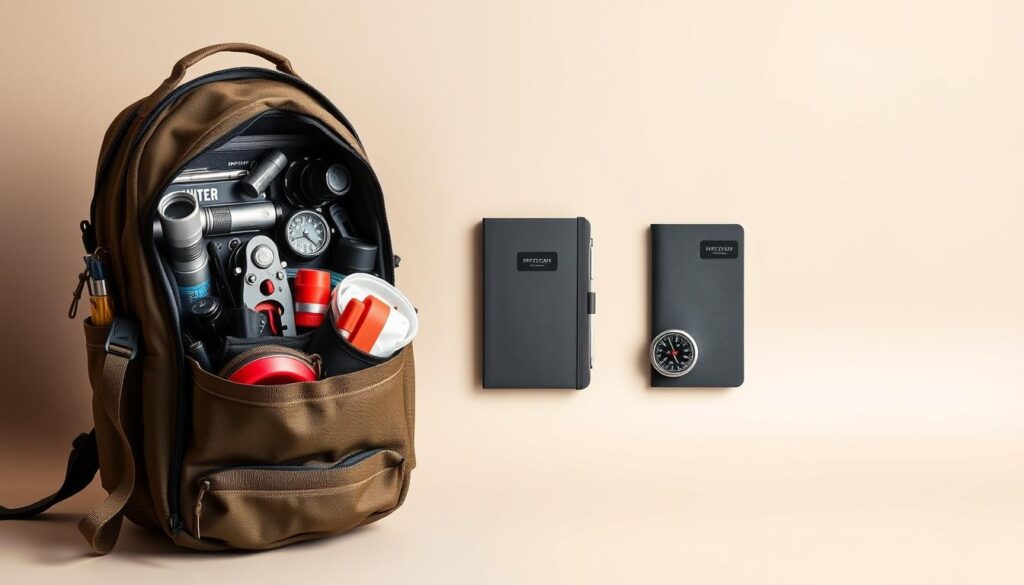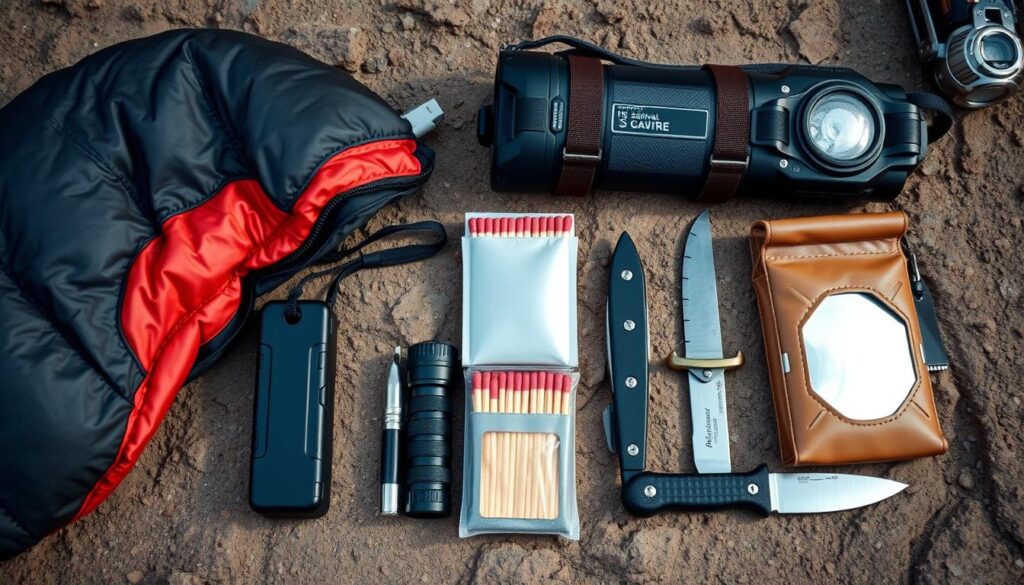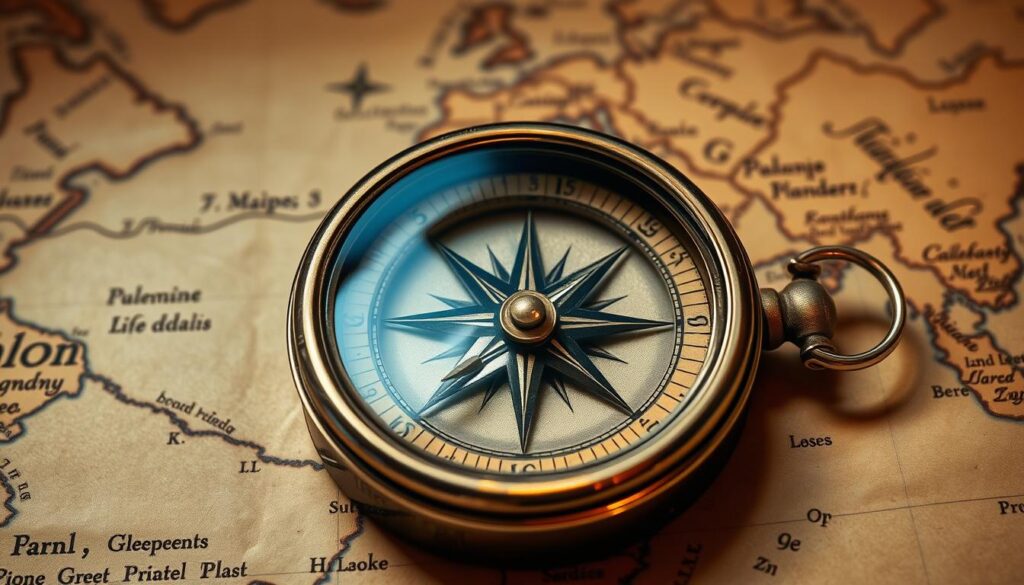When disaster hits, time is of the essence. A pre-packed emergency survival kit can mean the difference between safety and danger. I’ve learned this the hard way, and it’s a lesson that has stayed with me.
In uncertain times, being ready is vital. A compact emergency backpack is more than a bag; it’s a lifeline. It provides the basics needed to survive for up to 72 hours during emergencies or disasters.
Knowing the value of emergency preparedness is important. This guide is all about it. We’ll explore the must-haves for a portable survival kit. It can be your personal safety net in critical situations.
Key Takeaways
- A compact emergency backpack is essential for survival during emergencies or disasters.
- It should contain essentials to last for up to 72 hours.
- Being prepared is key in uncertain times.
- A pre-packed emergency survival kit can be a lifesaver.
- Understanding emergency preparedness is key to staying safe.
Understanding the Importance of a Compact Emergency Backpack
Having a compact emergency backpack is key for disaster survival and emergency response. It offers a portable, easy-to-access set of vital items for survival in emergencies.
This backpack’s value comes from its ability to provide essential supplies in emergencies like natural disasters and power outages. It’s a smart step to be ready for the unexpected.
Key Benefits of Having One
There are many good reasons to have a compact emergency backpack. First, it ensures you have what you need to survive for at least 72 hours. This includes food, water, first aid supplies, and ways to communicate. Second, it makes quick evacuation easier in emergencies, lowering the chance of getting stuck.
- Provides essential supplies for survival.
- Facilitates quick evacuation.
- Reduces risk during emergencies.
Situations to Prepare For
There are many situations to prepare for in emergency preparedness. Natural disasters like earthquakes, hurricanes, and floods are very important. Also, a compact emergency backpack is useful during road trips and travel emergencies, where help might be far away.
- Natural disasters (earthquakes, hurricanes, floods).
- Road trips and travel emergencies.
- Power outages and other infrastructure failures.
In summary, a compact emergency backpack is more than just a precaution. It’s a must-have for facing the unknown.
Choosing the Right Backpack
Choosing a durable bug out backpack is important. It’s a key part of emergency prep. You need to think about size and features for crisis readiness.
Size Considerations
The size of your backpack matters a lot. It should fit all your must-haves but be easy to carry. For short emergencies, a 20-30 liter backpack is usually enough.
- A smaller backpack is great for daily trips or short emergencies.
- For longer stays or evacuating with family, you’ll need a bigger one.
Essential Features to Look For
Your bug out backpack should be made of high-quality, water-resistant materials. It should have many pockets for organization. This helps you find what you need fast in a crisis.
Comfort is also key. Look for a backpack with padded straps and a breathable back panel. This keeps you comfy even when you’re wearing it for a long time.

For more tips on making the perfect bug out bag, check out this step-by-step guide. It will help you get ready for emergencies.
Must-Have Items for My Compact Emergency Backpack
To be ready for the unexpected, my emergency backpack needs the right stuff. It should have first aid supplies, food and water, and tools and accessories.
First Aid Supplies
A good first aid kit is key in an emergency. It should have bandages, antiseptic wipes, pain relievers, and any needed meds. A first aid manual is also a smart addition to help with injuries.
Food and Water Essentials
My backpack should have non-perishable food like energy bars and canned goods. It’s also important to have a way to purify water, like tablets or a filter. A small water bottle or hydration bladder is great for storing water.
Tools and Accessories
A multi-tool or pocket knife is useful for many tasks. A flashlight with extra batteries is essential for seeing in the dark. Other must-haves include a fire starter, a whistle, and a local map. These items can really help in survival situations.
In short, a compact emergency backpack needs the basics for immediate needs in a crisis. With first aid, food and water, and tools, I’m ready for emergencies.
Preparing for Various Scenarios
## Preparing for Various Scenarios
Being ready for different emergencies is key. I need to think about all kinds of disasters, from natural ones to travel issues. Having the right stuff and knowing what to do is vital for safety.
### Natural Disasters
Natural disasters like earthquakes, hurricanes, and floods are very dangerous. I should have a plan, like a safe meeting spot for my family and a way to communicate. I also need basic supplies like food, water, and first aid kits. For example, having a first aid kit ready for an earthquake is very important.
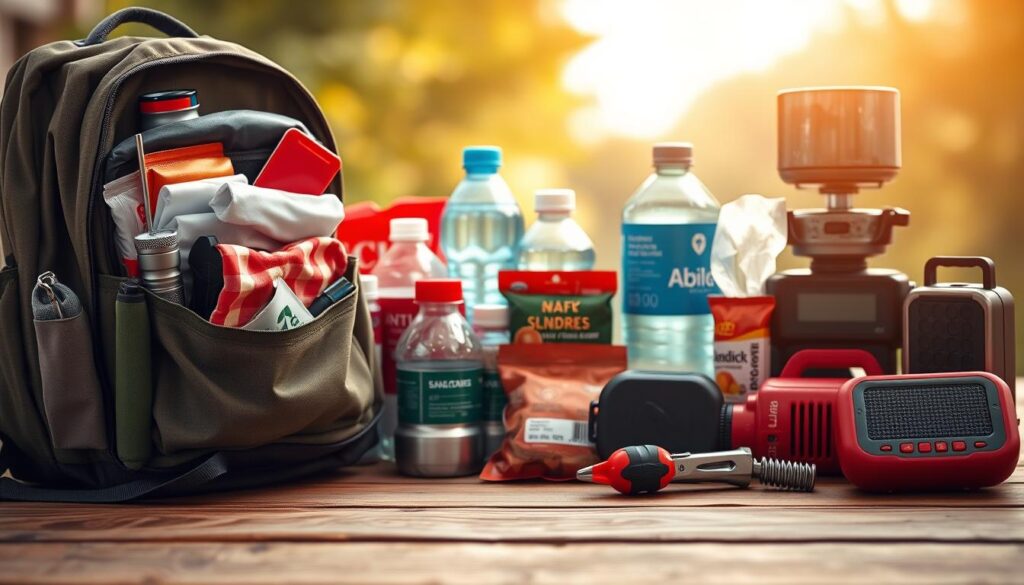
### Road Trips and Travel Emergencies
Travel emergencies, like car accidents or getting lost, can be scary. I should always carry a roadside emergency kit in my car. It should have jumper cables, a spare tire, and a basic first aid kit. Also, when traveling, it’s smart to know local emergency services and have a plan for emergencies. Knowing where hospitals are and how to communicate is important.
Being ready for different situations helps keep me and my loved ones safe. Good emergency planning means being informed and taking action to stay safe, no matter what.
Organizing My Emergency Supplies
To make the most of a compact emergency backpack, you need good packing strategies. Sort items into groups like first aid, food and water, and tools. This makes finding what you need easier when it matters most.
Packing Strategies
Good packing strategies are key for a well-organized backpack. Use cubes or pouches to keep things separate. Put items you use often in easy spots. Keep similar items together, like all first aid in one spot.
Also, pack items by how important they are. Put essentials like a first aid kit and water purification tablets where you can get to them fast. A checklist can help make sure you don’t forget anything important.
Weight Distribution Tips
Weight distribution is important when packing a backpack. Heavier items should be near your back to avoid strain. This keeps you balanced and prevents back pain.
Make sure the backpack fits right by adjusting the straps. This makes moving easier and helps carry the weight better. Paying attention to weight distribution makes your backpack more useful in emergencies.
Personalizing My Emergency Backpack
Creating a personalized emergency backpack is more than just packing essentials. It’s about making a kit that fits my family’s needs. I must think about what each family member, including kids and pets, might need.
Including Comfort Items
Comfort items are key for emotional support in tough times. For my family, that means favorite toys for the kids and personal mementos. These items help us feel more at ease. I also pack a first aid kit and other must-haves tailored to our needs.
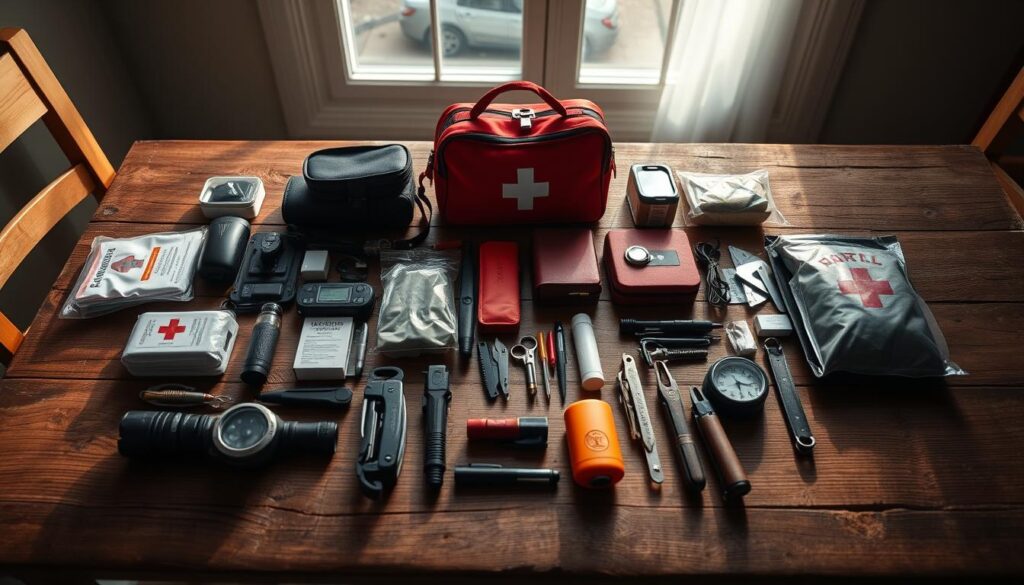
Tailoring to My Family's Needs
To make my emergency backpack fit my family, I consider age, health, and personal likes. For example, if someone has a health issue, I pack the right meds and gear. I also include a family emergency plan. This plan has our emergency contacts and how we’ll stay in touch.
| Family Member | Specific Needs |
|---|---|
| Children | Favorite toys, child-friendly medications |
| Adults | Medications, essential documents |
| Pets | Food, water, and medication for pets |
Maintenance and Updates
Keeping my emergency kit in top shape is a continuous effort. I regularly check supplies for expiration dates, damage, or when they’re running low. It’s important to make sure everything works and is easy to find.
Regularly Checking Supplies
To keep my emergency backpack ready, I inspect it often. I check the expiration dates of food, water, and medical items. This way, I replace them when needed.
For example, I check the first aid supplies like bandages and medicines. This ensures they’re good to use.
I also make sure all tools and equipment work well. This means testing flashlights, radios, and other key items.
Keeping My Backpack Ready
It’s not just about checking supplies; it’s also about keeping the backpack clean and organized. I make sure it’s tidy and easy to access. This helps me grab what I need quickly in an emergency.
For more tips on packing an emergency backpack, I look at resources like this guide. It offers great advice on being prepared.
By following these steps, I know my emergency backpack is always ready. It gives me the supplies and tools I need to face unexpected situations.
When to Use My Emergency Backpack
Knowing when to use my emergency backpack is key for disaster survival. It’s not just about having the right stuff. It’s also about knowing when to use it. Here, I’ll talk about the importance of spotting warning signs and making an emergency action plan.
Recognizing Warning Signs
Spotting warning signs is vital for knowing when to use my emergency backpack. These signs can include natural disaster alerts, evacuation orders, or other critical alerts. For example, during a hurricane, warning signs might include forecasted landfall times and evacuation orders.
It’s important to stay informed through reliable sources like the National Weather Service or local news.
Effective Action Plans
Having an effective action plan means knowing how to use my emergency backpack items. It also means knowing where to go and how to communicate with family during an emergency. For instance, if I’m in a wildfire-prone area, my plan should include knowing the safest evacuation routes.
To create a good plan, I should:
- Identify safe zones and escape routes.
- Know how to use essential items from my emergency backpack, such as first aid kits and communication devices.
- Establish a communication plan with family members, including a designated contact person outside the affected area.
For more info on making a personalized preparedness plan, check out this resource.
Educating My Family on Emergency Preparedness
To keep my family safe, I need to teach them about emergency preparedness. Emergency preparedness is more than just having the right gear. It’s about knowing what to do in an emergency. We must practice and talk about it to make sure we’re all ready.
Conducting Emergency Drills
Emergency drills are key to getting my family ready for emergencies. We practice evacuating and using our emergency backpack. This helps us find and fix problems early.
We practice leaving our home quickly and safely. We also talk about different emergency situations and how to use our supplies.
Discussing Emergency Plans
Talking about emergency plans with my family is important. We explain the plan to everyone, including kids. We cover emergency contact numbers and our meeting spot outside the home.
Discussing how to use emergency supplies helps everyone feel more confident. This open talk helps reduce fears and prepares us for emergencies.
By teaching my family about emergency preparedness, we become stronger together. We can face emergencies with confidence.
Resources for Further Learning
Staying ready for emergencies is important. To get better at emergency preparedness, I can look into emergency preparedness resources. This includes survival guides and online communities.
Recommended Guides
Survival guides are full of useful info. They cover everything from basic first aid to advanced survival skills. These guides give me clear steps and expert tips to boost my emergency readiness.
Online Communities
Being part of online emergency groups is also helpful. They let me share my experiences, ask questions, and get advice from others. By joining these groups, I can learn about the newest emergency preparedness methods and tips.
FAQ
What is a compact emergency backpack?
A compact emergency backpack is a small bag with essential items for survival in emergencies. It’s made to last up to 72 hours.
Why is having a compact emergency backpack important?
It’s vital because it offers a portable set of survival items. These are needed in emergencies like natural disasters or power outages. It’s easy to carry and access.
What are the essential items to include in a compact emergency backpack?
Key items include first aid like bandages and pain relievers. Also, food and water like non-perishables and water purification tablets. Don’t forget tools like a multi-tool and a flashlight with extra batteries.
How do I choose the right compact emergency backpack?
Look for a backpack that’s the right size and has the features you need. It should be durable, comfortable, and have lots of compartments. This ensures it’s good for daily use or for longer emergencies.
How often should I check and update my emergency backpack?
Check your supplies often for expiration, damage, or running out. Keep the backpack clean and organized. This makes sure everything works and is easy to find.
How do I personalize my emergency backpack for my family’s needs?
Add comfort items for emotional support during emergencies. Make sure it meets each family member’s needs, including kids and pets.
What are some effective packing strategies for my emergency backpack?
Organize items into categories and use packing cubes. Place heavy items near your back and balance the weight. This avoids strain.
How do I educate my family on emergency preparedness?
Teach your family by doing drills with the emergency backpack. Practice evacuating and discuss emergency plans. This ensures everyone knows what to do in an emergency.

